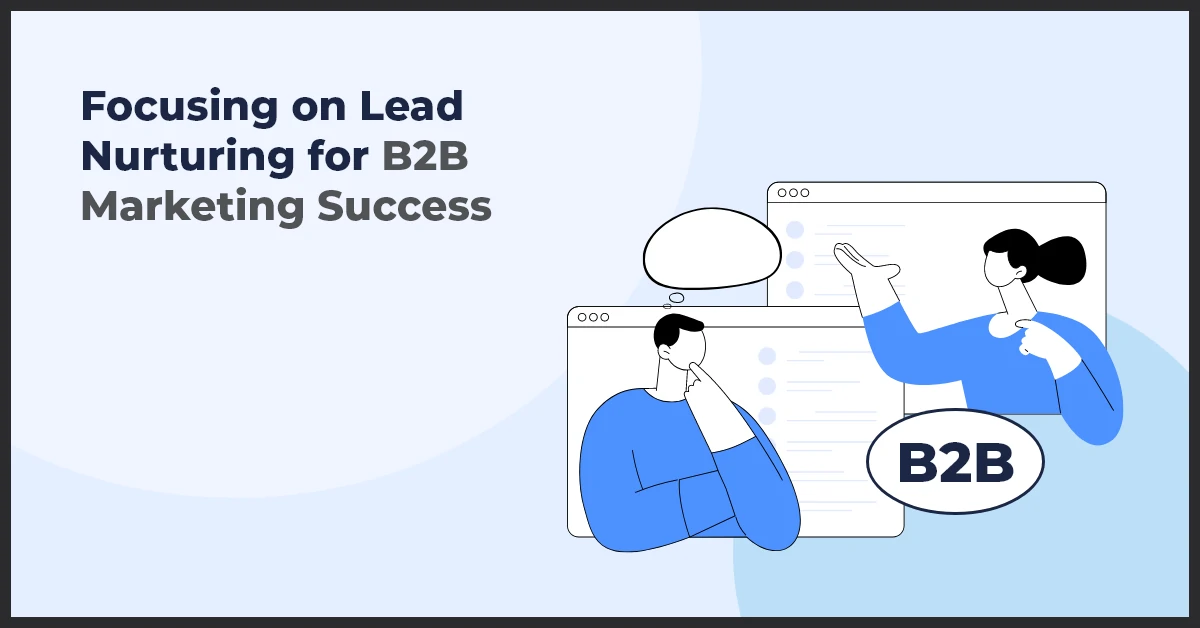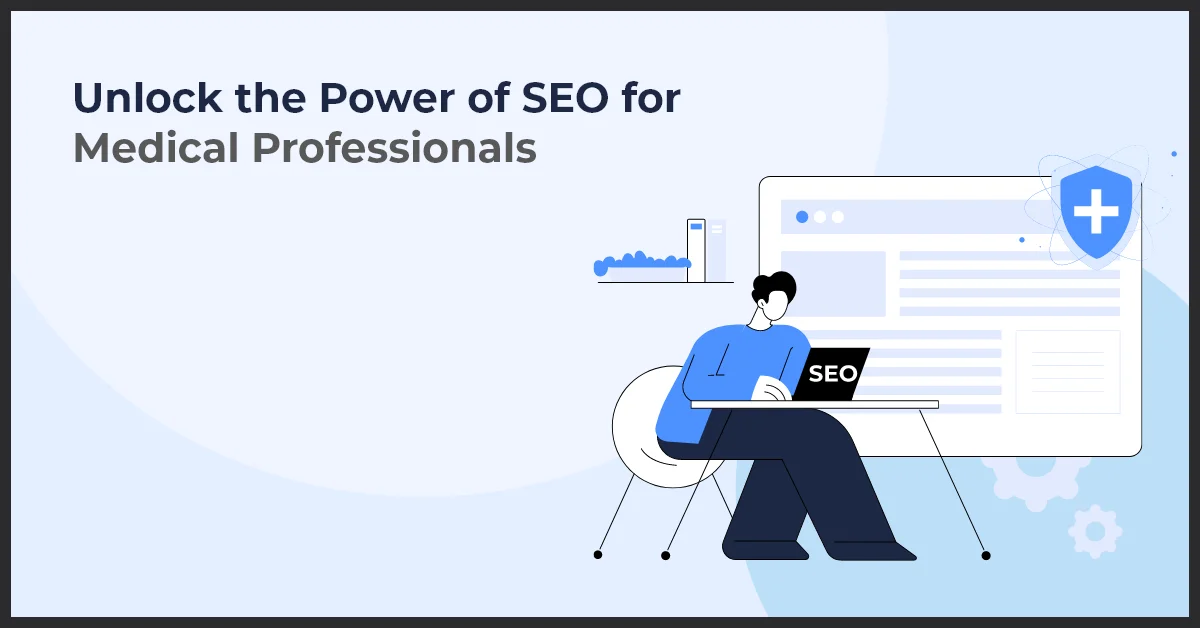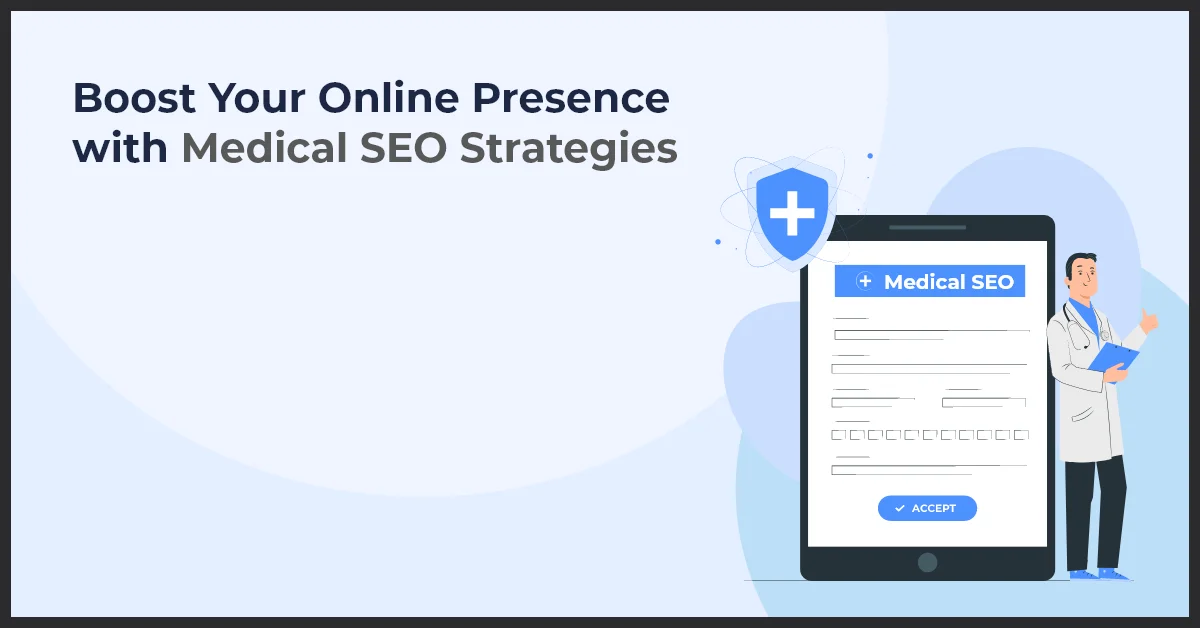Focusing on Lead Nurturing for B2B Marketing Success

Published on: August 23, 2021
Updated on: June 26, 2024
2113 Views
- Digital Marketing
12 min read
B2B marketing is unique due to multiple factors, including customer life cycle, long sales cycles, multiple buyer side stakeholders, cross-selling, and repeat sales.
Content-driven marketing strategies play a vital role in funnel optimization and lead nurturing. Therefore, your prospective clients need rich, robust, and meaningful content for quality lead generation and their conversion.
Before we move on to understand lead nurturing, let's discuss different stages of the lead funnel. These stages are ToFu (Top of the Funnel), MoFU (Middle of the Funnel), BoFu (Bottom of the Funnel), Post-purchase, Remarketing.
ToFu
At the top of the funnel, you need attention-grabbing tactics that spread awareness of your brand and establish you as a thought leader in your domain. Since it is the first brand outreach and exposure exercise, the net has to be cast wide.
You have to make the right impression with highly relevant and informative content. Such content by raising the brand awareness level helps build awareness and draws the customer to your door organically.
The most effective form of content at this stage is blog posts rich in facts and figures and industry knowledge. According to a survey conducted by the Content Marketing Institute, 73% of B2B marketers said that blogs were an effective way of taking customers to the next stage. As stated by HubSpot, 81% of companies consider their blogs “useful,” “important,” or “critical.”
The lead magnet is a problem-solving or winning content that should generate value for the customer. The lead magnet helps you increase your customer database by seeking customer’s information in lieu of productive downloadable content or utilities that could be of use to them. The content should be easily understandable and digestible. It could also be supported by visuals and illustrations.
Other modes of reaching and drawing the customers at the ToFu stage of lead nurturing are infographics, Datasheets, whitepapers, research papers, podcasts, and eBooks.
Read More: B2B Lead Nurturing - Your Key To Marketing Success
MoFu
By this stage, the customer has gained basic familiarity with your brand and industry. On the customer end, it is the heavily research-oriented evaluation phase. And for you, as a B2B marketer, begins the task of personalization and persuasion. MoFu stage content can give the leading edge in the competitive race if you address the “pain points” of the customer through unique solutions.
You can showcase your product or customer service excellence through comparison studies, customers’ testimonials and endorsements, etc. But content here should help in positioning the company right. Positioning is necessary or else “price war” is the only option for you to compete in the market. The content should, therefore, position your brand or the product as the best suited to meet the customer’s needs.
Some types of content relevant at this stage are FAQs, Demo Videos, How to Guides, Interactive meetings, whitepapers, and comparison charts.
Since it is also the “know each other better stage”, you need to win the trust of the customer by showcasing your reliability and credibility. You can impress them with the features of your products and services and luring them with the benefits your wares bring along. However, you should avoid the pushy sales mechanism. The content should be educational and designed around delivering a solution.
One of the most effective content types at this stage is the whitepaper and analyst coverage of your product or services. Customers find learning through the experiences of others more convincing than through your promises.
At the ToFu level, you spread your message far to let yourself be known. In MoFU, one has to be more targeted and build one-on-one messaging and positioning. One way to do it is to identify buyer behavior and then segment them for ongoing communication. A more targeted approach at this stage means higher conversions and better overall results.
MoFu bridges the gap between ToFu and BoFu stages of lead nurturing as the customer is pulled down into the funnel with the intention of leading them to conversion.
BoFu
The conversion or sale takes place where the funnel is narrowest. This is, perhaps, the most important stage of the funnel as the ultimate aim of gathering leads in the ToFu and MoFu stages is sales. The customer has reached this stage after thorough research and analysis and they are now looking for that single most motivating factor that shall make them take a decision in your favor.
This is the time when extensive consultations, demonstrations, free trials, cost estimates, and competitive benchmarking do the trick.
Studies have shown that B2B buyers are almost halfway through their purchase decision even before they contact an organization.
This is what gives all the more importance to in-depth case studies, which showcase the value of your products, services, or company. A well-framed case study that narrates how you solved the problem of a previous customer or addressed their needs is an asset in lead nurturing at the BoFu stage.
Now that the marketing automation process has drastically improved (thanks to the advancement in technology), B2B marketers have become smarter and keep the following essential elements in mind when nurturing their leads:
1. Streamlined Lead Management
In the B2B funnel, it is particularly important that we streamline leads through technology so that we reach them with the most appropriate message at the most appropriate time. Smart marketers first analyze the leads and understand their pain points, behavioral patterns, and what they are trying to indicate. Then they use various techniques in this process to pre-empt the future actions of their leads.
Once they understand the behavioral aspects of the leads within the funnel, they customize the lead communication process. Automated lead management systems allow marketing teams to take corrective action before the lead gets deviated from the right path. Lead indicators warn the marketing team in a timely manner so that every single lead is managed with the right approach. For example, if a regular customer has not been responding to the email for a week, the automated lead management system will inform the marketing team about this behavioral change. The management team will then communicate with the customer more effectively before he moves out of the lead funnel.
Important: Regularly review and update lead scoring criteria based on changing market trends and customer behavior patterns to ensure that your automated lead management system accurately prioritizes leads and triggers timely interventions for maximum effectiveness in lead nurturing.
2. Smarter Lead Generation
Once the lead management is done, B2B marketers push all their tactics to generate a sizable number of leads. As we know lead generation is just a process of bringing the potential buyers or subscribers into the radar, the overall conversion rate may remain in single digit. Hence, B2B marketers always try to grow their lead generation benchmark. More the number of leads in the funnel, a greater number of paid leads will be achieved.
Important: Focus on creating valuable and targeted content that addresses your target audience's specific pain points and needs to attract high-quality leads more effectively and improve overall lead generation outcomes.
3. Effortless Email Marketing
According to a study, 59% of B2B marketers see email marketing as the most effective revenue generation strategy. A whopping 79% of B2B marketers credit email as the most effective demand generation channel. Hence, we can say that setting up an email marketing system that gives the most effective and seamless experience to the marketer and the lead should be adopted. The utilization of CTA and lead magnets is important as leads will stick to the email channel if it is treated well. Here, buyer persona-based automated response and customized outreach are the two master keys.
Prioritize personalization in your email marketing efforts by tailoring content and messaging based on buyer personas and leveraging automation to deliver timely and relevant communications, ultimately enhancing engagement and driving better results.4. Seamless Sales Alignment
When a lead is communicated for the first time, it is within the periphery of the marketing team. But when a lead moves from MQL (Marketing Qualified Lead) level to SQL (Sales Qualified Lead) Level, the marketing team should involve the sales team to take charge. A marketing team will always be tasked to bring the lead down the funnel by winning the trust. The Sales team will help the lead move further towards paid subscriptions. This involves pushing special offers, sales, discount coupons, and other mediums which infuse urgency in the mind of the buyer. This process of passing on the lead to the sales team should be done in a subtle manner. The lead should not come to know that he is being handled by the sales team.
Important: Establish clear communication and handover criteria between marketing and sales teams to ensure smooth lead transitions, maintain trust, and enhance the customer experience.
5. Keeping a Tab on ROI Reporting
Return on investment is the key to setting benchmarks and the B2B marketing teams are always judged on this parameter. Since B2B marketing is more about serving the same client again by cross-selling, marketers should focus on B2B Lead Funnel metrics such as Client LTV, Lead conversion Rate, and Client Acquisition Cost. Deep dive into data improves the overall improvement in the lead management function.
Important: Regularly monitor ROI metrics like Client LTV, Lead Conversion Rate, and Client Acquisition Cost to optimize lead management and drive long-term profitability in B2B marketing.
6. Artificial Intelligence (AI)
Due to a lack of proper skillset, businesses often miss out on insight as data collected is disposed of or mismanaged, or considered redundant – resulting in poor pre-sales marketing strategy. Artificial Intelligence is the future of lead funnel augmentation. AI solves many problems like digital marketing automation, lead nurturing, data harvesting, conversational computing, and predictive analysis. AI will be the backbone for any modern B2B marketing framework.
Important: Embrace Artificial Intelligence (AI) to enhance lead funnel processes, automate marketing tasks, and leverage data for more effective lead nurturing, ultimately improving overall B2B marketing performance and competitiveness.
7. Omnichannel Marketing Enablement
B2B marketing is mainly about Keeping ROI in mind. It is also about developing a large top-funnel that can be nurtured through to sales conversion. B2B marketing does not always have the same stellar budgets as B2C marketing teams have. That is why channel selection is the most important decision in B2B marketing. Hence, taking an omnichannel approach means strategy and ROI benchmarks are decided from the beginning, it helps measure what works - allowing accurate attribution of results and enabling marketers to allocate budgets to channels that work best for them.
Important: Prioritize omnichannel marketing strategies to maximize ROI and ensure efficient resource allocation. Accurately measuring the effectiveness of each channel enables informed decision-making and optimized budget allocation.
8. Using A/B Testing
Investing time and money in client communication is a double-sided sword for B2B Marketers. It's always better to check what works better while communicating with the clients. Gradually, we develop a sense of what is appealing to our customers. This can be done through A/B Testing. A/B Testing enables us to track the success ratio of two different sets of communication. The success of each campaign can be measured by various metrics like open rate, click rate, and eCommerce conversion rate. Each communique can be broken down into differentiators like header text, color scheme, CTA visibility, and usage of buttons. The marketing team can evaluate which versions are more acceptable.
Important: Utilize A/B testing to optimize client communication by systematically testing different elements such as subject lines, visuals, and CTAs. It will enable data-driven decisions to enhance engagement and conversion rates.
9. Data Management and Segmentation of Leads
Data is the most important asset for any marketing team. Data helps teams understand where the marketing function is heading and what corrective measures are required. Each lead is important in B2B business and data helps in acquiring, converting, and nurturing leads. Hence data management is one of the most important functions of an ideal marketing automation process. Further, this data needs to be segmented on various parameters like demographic distribution, data source, behavioral aspects, etc.
Important: Implement robust data management practices and segment leads effectively based on demographics, behavior, and other relevant criteria to personalize marketing efforts, optimize conversion rates, and enhance overall campaign effectiveness.
10. Personalization at Scale
In the B2B marketing automation process, personalization is always considered a key result area for marketing teams. Each lead in the lead funnel carries a significant economic value for the organization. Personalization gives a relevant and delightful experience to the lead and ultimately drives them for paid conversion. Automation allows the marketing function to communicate smoothly with each lead at each level of the lead funnel. A successful marketer efficiently uses AI to create a seamless communication setup.
Important: Leverage AI-driven automation to personalize communication at scale, delivering relevant content and experiences to each lead throughout the funnel, thereby maximizing engagement and driving conversions.
Every B2B business needs to focus on these elements that make a framework that leads to guaranteed long-term success.
Key Takeaways
- Content Tailoring by Funnel Stage: Tailor content to match the buyer's journey stage, providing informative blog posts for ToFu, solution-focused FAQs and demo videos for MoFu, and in-depth case studies for BoFu, ensuring relevance and effectiveness at each stage.
- Data-Driven Optimization: Utilize A/B testing for communication strategies, segment leads based on demographic and behavioral data, and prioritize personalization at scale using AI, enabling data-driven decision-making, efficient lead segmentation, and personalized communication for enhanced lead nurturing and conversion.
Contact us at info@growthnatives.com for expert assistance with all your B2B lead nurturing needs.
Frequently Asked Questions
Lead nurturing in B2B involves cultivating relationships with potential buyers through targeted communication and relevant content to guide them through the sales funnel until they are ready to purchase.
The B2B lead generation strategy involves identifying and attracting potential business customers through various marketing tactics such as content marketing, email campaigns, social media engagement, and networking events.
Targeted marketing efforts can attract B2B leads, including creating valuable content, participating in industry events, leveraging social media platforms, optimizing SEO strategies, and offering incentives for engagement.
There are typically three stages in B2B lead generation: awareness, consideration, and decision. These stages represent the progression of a prospect from learning about a solution to evaluating options and making a purchasing decision.
The best B2B lead generation methods include content marketing, email marketing, networking and referrals, and search engine optimization (SEO). These strategies help businesses attract and engage potential leads effectively.
Building B2B loyalty involves providing excellent customer service, delivering high-quality products or services, maintaining transparent communication, offering personalized experiences, and consistently delivering customer value over time.
Four efficient lead generation strategies for B2B marketers are content marketing, email marketing, LinkedIn marketing, and webinars. These methods help attract and engage potential leads by providing valuable information and building relationships.
After lead nurturing, the next step is typically lead qualification and conversion. This involves assessing the readiness of leads to make a purchase decision, identifying the most promising prospects, and guiding them through the sales process to convert them into paying customers.



